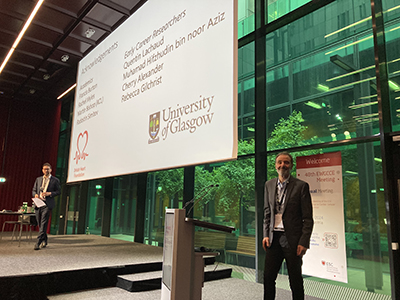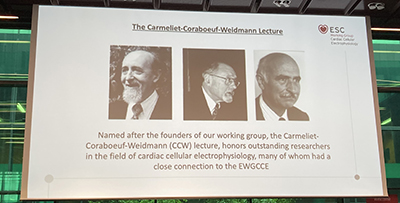Professor Godfrey Smith Delivers Highly Prestigious Keynote Lecture at EWGCCE 2024
Published: 20 August 2024
Prof. Godfrey Smith presents the Carmeliet-Coraboeuf-Weidman Lecture

This year the 48th meeting of the ESC Working Group on Cardiac Cellular Electrophysiology (EWGCCE) was held in Graz, Austria (1st – 3rd July) and was attended by the Workman research group and Professor Godfrey Smith, the latter for a very special reason.
The first day of the meeting showcased excellent and emerging research from members of the working group on the cellular mechanisms of arrhythmias, discussing potential new pathological understanding and mechanistic insight as well as therapeutic intervention. The final session of the first day was chaired by Prof. Jordi Heijman of the Gottfried Schatz Research Center and past chairperson of the working group. Prof. Heijman introduced Godfrey as an “internationally renowned cardiac scientist” as he invited him to the stage to present his research as part of the prestigious Carmeliet-Corabeuf-Weidman lecture series. Each year the working group invites one specially selected researcher who has excelled and whose research has expanded the field of electrophysiology to present their work at the EWGCCE meeting. Previous awardees include impressive names in the field such as Prof. Denis Noble, Prof. Karin Sipido, Prof. David Eisner and Prof. Dobromir Dobrev.

This year Godfrey was the recipient of this difficult to achieve honour with his presentation titled “Cardiac cellular electrophysiology: from cell to syncytium”. He began by discussing some of his inspirations, particularly a quote by Lord Kelvin from his time as an undergraduate, “I can never satisfy myself until I make a mechanical model of a thing. If I can make a mechanical model, I can understand it.” Discussing cell-cell variability Godfrey posed the question “is cell-cell variability greater than whole heart-heart variability?” Presenting his work on various models and how each furthered our understanding of this variability, he ended by presenting some of his latest ongoing work and thanked his colleagues and collaborators for their contributions. This was followed by a networking event for attendees, where I spoke to fellow researchers about how they received the keynote lecture. Many echoed that Godfrey was highly deserving, and his work had created a “new international standard”.
The following days of the meeting were filled with fantastic talks from other researchers and students, including two poster sessions. Overall, it was a fantastic meeting in a beautiful location, and we look forward to attending more meetings in the future. Congratulations to Prof. Smith for this wonderful achievement and the well deserved recognition of his career!
First published: 20 August 2024

